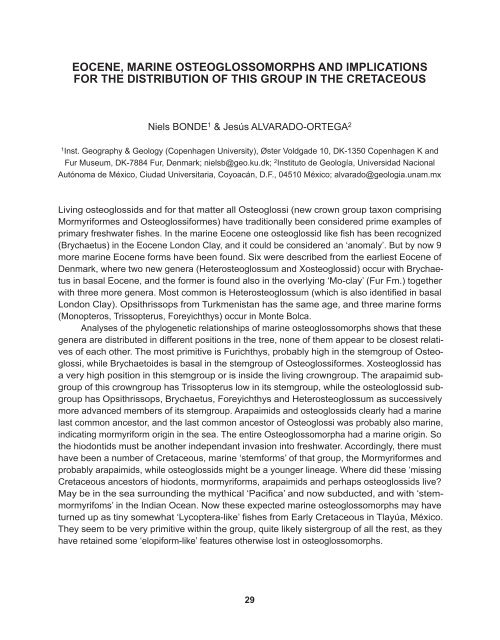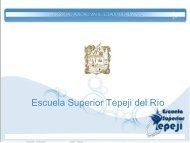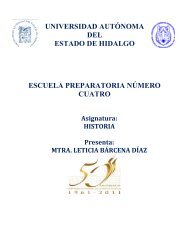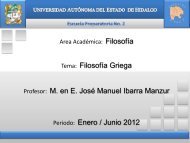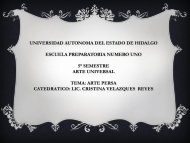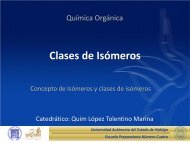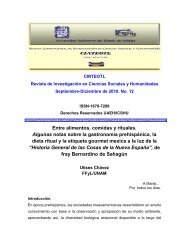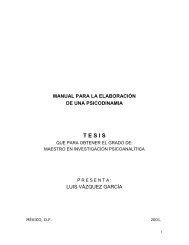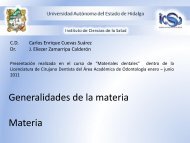Untitled-2 1 05/07/10 16:35 - Universidad Autónoma del Estado de ...
Untitled-2 1 05/07/10 16:35 - Universidad Autónoma del Estado de ...
Untitled-2 1 05/07/10 16:35 - Universidad Autónoma del Estado de ...
Create successful ePaper yourself
Turn your PDF publications into a flip-book with our unique Google optimized e-Paper software.
EOCENE, MARINE OSTEOGLOSSOMORPHS AND IMPLICATIONS<br />
FOR THE DISTRIBUTION OF THIS GROUP IN THE CRETACEOUS<br />
Niels BONDE 1 & Jesús ALVARADO-ORTEGA 2<br />
1 Inst. Geography & Geology (Copenhagen University), Øster Voldga<strong>de</strong> <strong>10</strong>, DK-1<strong>35</strong>0 Copenhagen K and<br />
Fur Museum, DK-7884 Fur, Denmark; nielsb@geo.ku.dk; 2 Instituto <strong>de</strong> Geología, <strong>Universidad</strong> Nacional<br />
<strong>Autónoma</strong> <strong>de</strong> México, Ciudad Universitaria, Coyoacán, D.F., 045<strong>10</strong> México; alvarado@geologia.unam.mx<br />
Living osteoglossids and for that matter all Osteoglossi (new crown group taxon comprising<br />
Mormyriformes and Osteoglossiformes) have traditionally been consi<strong>de</strong>red prime examples of<br />
primary freshwater fishes. In the marine Eocene one osteoglossid like fish has been recognized<br />
(Brychaetus) in the Eocene London Clay, and it could be consi<strong>de</strong>red an ‘anomaly’. But by now 9<br />
more marine Eocene forms have been found. Six were <strong>de</strong>scribed from the earliest Eocene of<br />
Denmark, where two new genera (Heterosteoglossum and Xosteoglossid) occur with Brychaetus<br />
in basal Eocene, and the former is found also in the overlying ‘Mo-clay’ (Fur Fm.) together<br />
with three more genera. Most common is Heterosteoglossum (which is also i<strong>de</strong>ntified in basal<br />
London Clay). Opsithrissops from Turkmenistan has the same age, and three marine forms<br />
(Monopteros, Trissopterus, Foreyichthys) occur in Monte Bolca.<br />
Analyses of the phylogenetic relationships of marine osteoglossomorphs shows that these<br />
genera are distributed in different positions in the tree, none of them appear to be closest relatives<br />
of each other. The most primitive is Furichthys, probably high in the stemgroup of Osteoglossi,<br />
while Brychaetoi<strong>de</strong>s is basal in the stemgroup of Osteoglossiformes. Xosteoglossid has<br />
a very high position in this stemgroup or is insi<strong>de</strong> the living crowngroup. The arapaimid subgroup<br />
of this crowngroup has Trissopterus low in its stemgroup, while the osteologlossid subgroup<br />
has Opsithrissops, Brychaetus, Foreyichthys and Heterosteoglossum as successively<br />
more advanced members of its stemgroup. Arapaimids and osteoglossids clearly had a marine<br />
last common ancestor, and the last common ancestor of Osteoglossi was probably also marine,<br />
indicating mormyriform origin in the sea. The entire Osteoglossomorpha had a marine origin. So<br />
the hiodontids must be another in<strong>de</strong>pendant invasion into freshwater. Accordingly, there must<br />
have been a number of Cretaceous, marine ‘stemforms’ of that group, the Mormyriformes and<br />
probably arapaimids, while osteoglossids might be a younger lineage. Where did these ‘missing<br />
Cretaceous ancestors of hiodonts, mormyriforms, arapaimids and perhaps osteoglossids live?<br />
May be in the sea surrounding the mythical ‘Pacifica’ and now subducted, and with ‘stemmormyrifoms’<br />
in the Indian Ocean. Now these expected marine osteoglossomorphs may have<br />
turned up as tiny somewhat ‘Lycoptera-like’ fishes from Early Cretaceous in Tlayúa, México.<br />
They seem to be very primitive within the group, quite likely sistergroup of all the rest, as they<br />
have retained some ‘elopiform-like’ features otherwise lost in osteoglossomorphs.<br />
29


